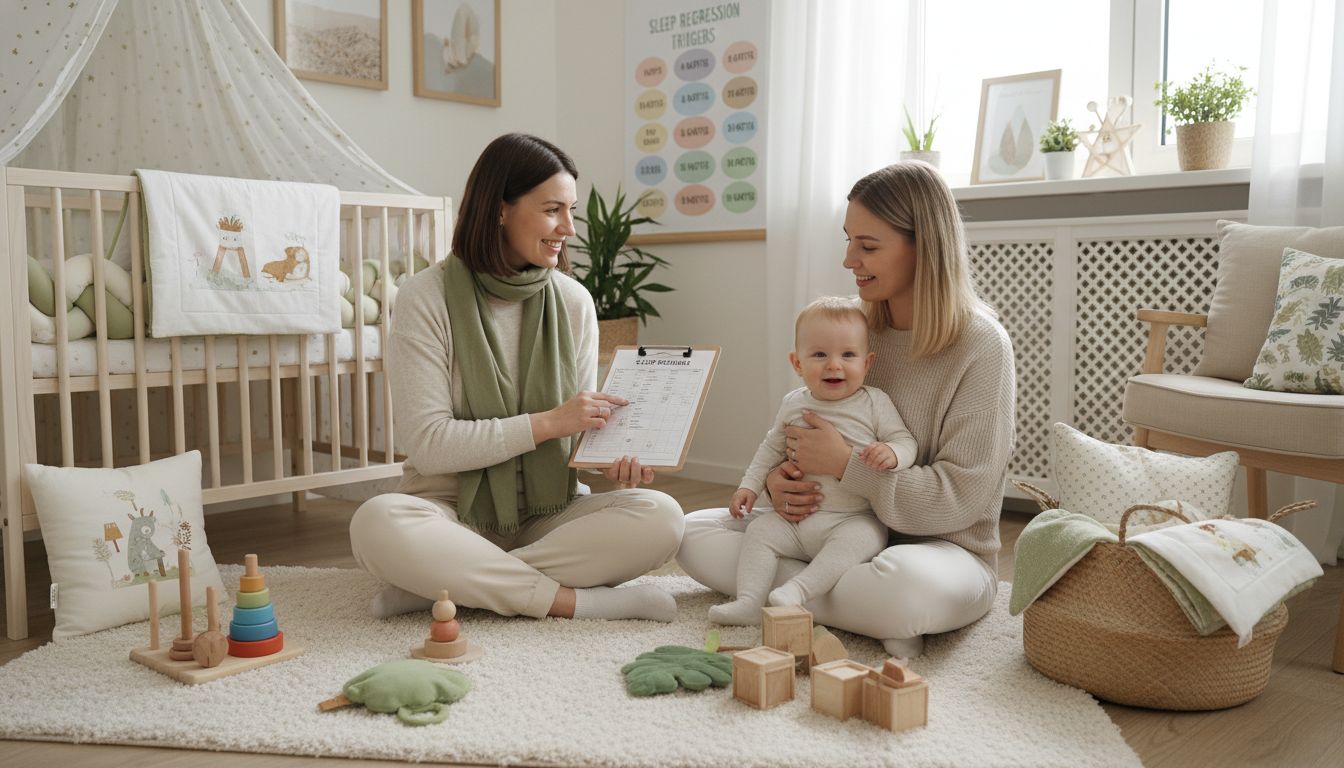Alrededor del 80% de los bebés experimentan alteraciones del sueño durante sus dos primeros años, lo que deja a muchos padres desconcertados y con falta de sueño. Si las noches tranquilas de tu bebé se convierten de repente en noches de inquietud, no estás solo. Estos cambios impredecibles suelen generar preocupación y confusión, pero son una parte natural del desarrollo temprano. Al comprender qué significa realmente la regresión del sueño y aclarar los mitos más comunes, podrás afrontar estas noches difíciles con más confianza y menos estrés.
Tabla de contenido
- Definición de regresión del sueño y mitos comunes
- Edades típicas y factores desencadenantes del desarrollo
- Reconocer los signos de regresión del sueño
- Cómo la regresión del sueño afecta a los bebés y a los padres
- Estrategias efectivas para controlar la regresión del sueño
Conclusiones clave
| Punto | Detalles |
|---|---|
| Comprender la regresión del sueño | La regresión del sueño es una fase transitoria en los bebés caracterizada por alteraciones en los patrones de sueño debido a los hitos del desarrollo. No es una afección médica, sino una experiencia común entre los padres. |
| Reconocer los desencadenantes del desarrollo | Las edades clave para las regresiones del sueño, como los 4, 6, 8, 12 y 24 meses, corresponden a desarrollos significativos como el aumento de la movilidad y el crecimiento emocional. |
| Gestionar eficazmente la regresión del sueño | Establezca rutinas consistentes a la hora de acostarse y cree un ambiente tranquilo para dormir que ayude a superar las regresiones del sueño. Los padres deben ser flexibles y estar atentos a las necesidades cambiantes de su bebé. |
| Priorizar el bienestar de los padres | Los padres deben priorizar su propio descanso y salud mental durante los períodos de regresión del sueño para poder apoyar eficazmente a su bebé y mantener el equilibrio emocional. |
Definición de regresión del sueño y mitos comunes
La regresión del sueño es una fase difícil que muchos padres experimentan con sus bebés, caracterizada por alteraciones repentinas en los patrones de sueño establecidos. No se trata de un diagnóstico médico, sino de un término ampliamente utilizado para describir cambios temporales en la rutina de sueño del niño, que suelen coincidir con hitos importantes del desarrollo.
Según Medical News Today , actualmente no existe un consenso médico estricto sobre la definición precisa de regresión del sueño. A pesar de su popularidad entre los padres, la investigación científica sigue siendo limitada. El fenómeno suele manifestarse como:
- Mayor vigilia nocturna
- Dificultad para conciliar el sueño
- Duración de las siestas más cortas
- Despertares nocturnos más frecuentes
- Mayor irritabilidad a la hora de acostarse
Los mitos comunes sobre la regresión del sueño suelen generar ansiedad innecesaria en los padres. Una idea errónea muy extendida es que la regresión del sueño ocurre a edades específicas. En realidad, los cambios en el desarrollo se producen de forma gradual, y la experiencia de cada niño varía considerablemente. Algunos bebés pueden experimentar alteraciones del sueño alrededor de los 4, 8 o 12 meses, mientras que otros pueden no mostrar cambios notables.
Otro mito importante que debemos desmentir es que la regresión del sueño significa que algo anda mal con tu bebé. El desarrollo normal suele provocar estos cambios temporales en los patrones de sueño. Tu bebé no tiene ningún problema, simplemente está atravesando etapas naturales de crecimiento neurológico y físico que alteran momentáneamente su rutina de sueño establecida.
Edades típicas y factores desencadenantes del desarrollo
La regresión del sueño no es un fenómeno aleatorio, sino un patrón predecible estrechamente ligado al desarrollo del bebé. Los hitos del desarrollo juegan un papel crucial en la aparición de estas alteraciones temporales del sueño, y ciertas edades marcan cambios más pronunciados en los patrones de sueño del bebé.
Según Medical News Today, las regresiones del sueño suelen aparecer en torno a varias edades clave:
- 4 meses : Primera regresión importante del sueño
- 6 meses : Mayor movilidad y consciencia
- 8 meses : Ansiedad por separación y saltos cognitivos
- 12 meses : Caminar y mayor independencia
- 24 meses : Desarrollo del lenguaje y complejidad emocional
Cada una de estas edades se corresponde con etapas importantes del desarrollo neurológico y físico. A los 4 meses, los bebés experimentan un cambio drástico en sus ciclos de sueño, pasando de patrones de sueño propios de recién nacidos a otros más similares a los de un adulto. Alrededor de los 6 meses, el aumento de la movilidad, como darse la vuelta y sentarse, puede alterar las rutinas de sueño establecidas. La regresión de los 8 meses suele coincidir con la ansiedad por separación , durante la cual los bebés se vuelven más conscientes de su entorno y desarrollan un mayor apego emocional a sus cuidadores.
Las regresiones de los 12 y 24 meses son particularmente intensas y se caracterizan por importantes saltos en el desarrollo. Caminar, el desarrollo del lenguaje y la creciente independencia generan una estimulación mental y emocional que puede afectar significativamente el sueño. Durante estas etapas, los bebés procesan una enorme cantidad de información nueva, lo que puede provocar mayor vigilia nocturna y dificultad para conciliar el sueño.
Comprender estos desencadenantes ayuda a los padres a afrontar las regresiones del sueño con paciencia y apoyo estratégico, reconociéndolas como partes naturales del desarrollo infantil en lugar de interrupciones problemáticas.

Aquí tenéis un resumen de las edades más comunes de regresión del sueño y sus desencadenantes del desarrollo:
| Edad aproximada | Principales desencadenantes del desarrollo | Cambios típicos del sueño |
|---|---|---|
| 4 meses | maduración del ciclo del sueño Mayor conciencia |
Más despertares nocturnos Siestas más cortas |
| 6 meses | Laminación Sentado Movilidad |
Problemas para conciliar el sueño Despertarse frecuentemente por la noche |
| 8 meses | ansiedad por separación Habilidades cognitivas |
Resistencia a la hora de acostarse Aferramiento |
| 12 meses | Caminando Mayor independencia |
Mayor inquietud Cambios en la siesta |
| 24 meses | saltos lingüísticos Crecimiento emocional |
Despertares nocturnos Inquietud a la hora de acostarse |
Reconocer los signos de regresión del sueño
La regresión del sueño puede ser una experiencia desconcertante para los padres, ya que a menudo los toma por sorpresa con cambios repentinos y drásticos en los patrones de sueño de su bebé. Comprender los indicadores clave ayuda a los padres a diferenciar entre las variaciones normales del sueño y los episodios de regresión propiamente dichos. Conocer las recomendaciones para un sueño seguro en bebés puede brindar información adicional sobre estos períodos difíciles.
Según Medical News Today, los signos más comunes de regresión del sueño incluyen:
- Aumento drástico de los despertares nocturnos
- Dificultad para conciliar el sueño o permanecer dormido
- Duración de las siestas más cortas
- Mayor irritabilidad durante las rutinas a la hora de acostarse
- Resistencia repentina a las estrategias de sueño habituales
- Llorar más a menudo por la noche
Estos trastornos del sueño suelen ir acompañados de cambios físicos y emocionales. Los padres pueden notar que su bebé se vuelve más dependiente, experimenta mayor ansiedad por separación o muestra mayor inquietud al dormir.
Estas señales suelen coincidir con hitos importantes del desarrollo, como el aprendizaje de nuevas habilidades motoras o el crecimiento cognitivo. El cerebro del bebé está procesando activamente nueva información, lo que puede alterar temporalmente los patrones de sueño establecidos.
Es fundamental distinguir entre una regresión del sueño temporal y posibles problemas de salud subyacentes. Si bien las alteraciones del sueño ocasionales son normales, los cambios persistentes que duran más de dos semanas podrían justificar una consulta pediátrica. La mayoría de las regresiones del sueño son fases temporales que se resuelven naturalmente a medida que el bebé se adapta a las nuevas etapas de su desarrollo. Mantener rutinas consistentes a la hora de acostarse, crear un ambiente tranquilo para dormir y practicar la paciencia puede ayudar a los padres a sobrellevar estos períodos difíciles con mayor facilidad y comprensión.
Cómo la regresión del sueño afecta a los bebés y a los padres
La regresión del sueño crea un entorno emocional y físico complejo tanto para los bebés como para sus cuidadores, transformando una rutina predecible en un desafío impredecible. Estos periodos de alteración pueden modificar significativamente la dinámica familiar, poniendo a prueba la paciencia y la resiliencia de los padres y, al mismo tiempo, representando hitos cruciales en el desarrollo de los bebés.
Según Medical News Today, el impacto en los bebés durante la regresión del sueño incluye:
- Mayor vulnerabilidad emocional
- Mayores niveles de frustración
- Procesamiento cognitivo interrumpido
- estrés potencial del desarrollo
- Reducción temporal de la calidad general del sueño
- Mayor necesidad de consuelo parental
Los padres que experimentan regresión del sueño en sus bebés a menudo se enfrentan a importantes desafíos personales. La privación crónica del sueño puede provocar una disminución de la claridad mental, un aumento del estrés y posibles tensiones emocionales en las relaciones. Comprender el método de entrenamiento del sueño suave para bebés puede brindar estrategias valiosas para afrontar estos periodos difíciles. El efecto acumulativo de los ciclos de sueño interrumpidos puede tener un efecto dominó, afectando el rendimiento laboral, las relaciones personales y el bienestar general.
Curiosamente, aunque la regresión del sueño pueda parecer algo totalmente negativo, representa un periodo crucial de crecimiento neurológico y emocional para los bebés. Los bebés están experimentando cambios significativos en su desarrollo, lo que altera temporalmente sus patrones de sueño. Para los padres, comprender este contexto puede transformar la frustración en compasión, reconociendo estas semanas difíciles como fases transitorias en el extraordinario viaje de crecimiento y autodescubrimiento de sus hijos. Mantener la perspectiva, practicar el autocuidado y desarrollar estrategias de sueño flexibles puede ayudar a las familias a sobrellevar con éxito estos periodos intensos pero transformadores.
Estrategias efectivas para controlar la regresión del sueño
La regresión del sueño puede resultar abrumadora, pero ciertas estrategias pueden ayudar a los padres a afrontar estos periodos difíciles con mayor confianza y tranquilidad. Comprender e implementar estrategias específicas puede transformar una experiencia frustrante en una oportunidad para fortalecer el vínculo con el bebé y apoyar su desarrollo.
Según Medical News Today, las estrategias de tratamiento más eficaces incluyen:
- Mantener una rutina consistente a la hora de acostarse
- Crear un ambiente de sueño tranquilo y predecible
- Ofrecer confort sin crear asociaciones negativas con el sueño.
- Practicar la paciencia y la regulación emocional
- Adaptar las estrategias de sueño a las necesidades cambiantes de tu bebé
- Prioriza tu propio descanso y tu salud mental.
Establecer una rutina relajante a la hora de dormir es fundamental durante la regresión del sueño. Esto puede incluir actividades suaves como música relajante, luces tenues, cuentos en voz baja o rutinas de mimos constantes. Comprender el método de entrenamiento del sueño suave para bebés puede brindar información adicional para crear transiciones de sueño efectivas. Los padres deben centrarse en crear patrones predecibles que le indiquen al bebé que es hora de relajarse, siendo lo suficientemente flexibles para adaptarse a los cambios en su desarrollo.
Fundamentalmente, para manejar la regresión del sueño se requiere un enfoque integral que equilibre las necesidades emocionales del bebé con estrategias prácticas para dormir. Esto implica responder a los despertares nocturnos con tranquilidad y seguridad, evitar la sobreestimulación y enseñar gradualmente técnicas de autorregulación. Recuerda que cada bebé es único y lo que funciona para uno puede no funcionar para otro. La clave está en mantener la constancia, mostrar compasión y comprender que estas fases difíciles son etapas temporales en el increíble proceso de crecimiento de tu hijo.
Crea una habitación infantil acogedora y segura para facilitar las regresiones del sueño.
La regresión del sueño provoca cambios repentinos en los patrones de sueño de tu bebé que pueden preocupar a cualquier padre. El aumento de la vigilia y la irritabilidad que experimenta tu pequeño durante esta etapa requiere más que paciencia: necesita un entorno de sueño seguro y relajante que favorezca el descanso y la comodidad. Al centrarte en rutinas y entornos tranquilos y constantes, ayudarás a tu bebé a adaptarse mejor a estas alteraciones temporales.

Descubre nuestros juegos de cama para bebés hipoalergénicos, hechos a mano en Kari Studio, diseñados pensando en la máxima suavidad y seguridad. Nuestras opciones personalizables te permiten crear un espacio único para la habitación del bebé que refleje tu estilo y fomente hábitos de sueño seguros. Descubre cómo elementos esenciales como protectores de cuna trenzados y protectores de barandilla pueden reducir el llanto nocturno y crear un refugio tranquilo para tu hijo durante sus etapas de desarrollo. Transforma hoy mismo la habitación de tu bebé en un oasis de tranquilidad que facilite la transición al sueño, tanto para ti como para tu pequeño.
Preguntas frecuentes
¿Qué es la regresión del sueño?
La regresión del sueño se refiere a alteraciones temporales en los patrones de sueño establecidos de un niño, a menudo vinculadas a hitos importantes del desarrollo. No es un diagnóstico médico, sino una fase común que experimentan muchos padres.
¿Cuándo suelen producirse las regresiones del sueño?
Las regresiones del sueño suelen ocurrir alrededor de edades clave del desarrollo, como los 4 meses, 6 meses, 8 meses, 12 meses y 24 meses, generalmente coincidiendo con hitos específicos como el aumento de la movilidad y la ansiedad por separación.
¿Cuáles son los síntomas de la regresión del sueño?
Los signos comunes de regresión del sueño incluyen un aumento de los despertares nocturnos, dificultad para conciliar el sueño, siestas más cortas, mayor irritabilidad durante las rutinas a la hora de acostarse y una repentina resistencia a las estrategias habituales para dormir.
¿Cómo puedo manejar eficazmente la regresión del sueño de mi bebé?
Para controlar la regresión del sueño, establezca una rutina consistente a la hora de acostarse, cree un ambiente tranquilo para dormir, ofrezca consuelo sin asociaciones negativas, practique la paciencia y adapte sus estrategias a las necesidades cambiantes de su bebé.

